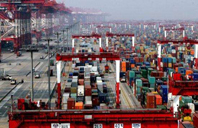by Angus Grigg
China wants more home furnishings and medicine, less pork and the same amount of jewellery.
The full-year GDP data released on Friday, which showed China's economy grew by 6.8 per cent in the fourth quarter. The stronger than expected finish to the year delivered annual growth of 6.7 per cent, the slowest pace in 26 years, but far stronger than most economist had predicted just 12 months ago.
While the headline numbers in China are always read with some scepticism, a breakdown of the figures show how tastes in the world's second largest economy are changing.
The strongest growth from a single category was 14 per cent from materials used in construction and interior decoration, while furniture sales were up 12.7 per cent over the year.
This could reflect a surge in the birth rate during 2016, after China's "one child policy" was scrapped the previous year. The National Bureau of Statistics said there were 17.9 million babies born across China last year, up 8 per cent or 1.3 million from 2015.
Home sales were also stronger, rising 36 per cent, after local governments eased restrictions on purchases.
The other standout category for 2016 was medicine sales, which grew by 12 per cent to 846 billion yuan ($162 billion).
China's ageing population, poor air quality, increased wealth and changed diet are mostly responsible for the surge in demand for health and pharmaceutical products.
Rates of diabetes, for instance, have more than doubled over the last two decades with an estimated 110 million people or 10 per cent of adults living with the disease.
By contrast sales of jewellery, once a stellar growth category, were unchanged in 2016.
"The Chinese consumer story remained very healthy last year," said Andy Rothman, the investment strategist at Matthews Asia.
He pointed out retail sales grew at 9.6 per cent last year when adjusted for inflation, slightly slower than the 10.6 per cent in 2015, but far stronger than growth in the US of 1.7 per cent.
Overall in 2016 consumption contributed 64.6 per cent of China's GDP growth, up from just 42 per cent in 2006.
"I believe China will remain the world's best consumer story [in 2017]," said Mr Rothman in a note to clients.
The annual production of pork, the most popular source of protein in China, declined by 3.4 per cent, while output of beef, mutton and poultry all rose by more than 2.4 per cent.
After forecasts of big declines for crude steel production in 2016, output was up 1.2 per cent to 808.4 million tonnes.
While many have questioned China's headline growth numbers, other indicators show the world's second biggest economy picked up strongly in the second half of the year, after Beijing pumped a fresh round of credit stimulus into the economy.
Other data released on Friday showed fixed asset investment (construction) finished 2016 in line with expectations, growing 8.1 per cent for the 12 months, weaker than the 10.7 per cent in the first three months of the year.
Industrial production was slightly weaker in December, growing by 6 per cent, after peaking at 6.8 per cent over the first three months of the year.
China's coal production fell 9.4 per cent for the full year, compared with 2015.
(Source: www.afr.com/)





 沪公网安备31010402003309号
沪公网安备31010402003309号



